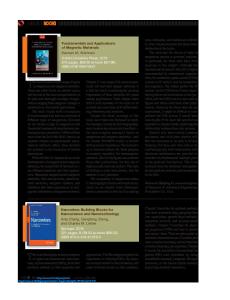N- and P-Type Building Blocks for Organic Electronics Based on Oligothiophene Cores
- PDF / 263,193 Bytes
- 6 Pages / 612 x 792 pts (letter) Page_size
- 113 Downloads / 269 Views
L12.8.1/H11.8.1
N- and P-Type Building Blocks for Organic Electronics Based on Oligothiophene Cores Antonio Facchetti1, Myung-Han Yoon2, Howard E. Katz2, Melissa Mushrush2, and Tobin J. Marks*1 1 Department of Chemistry and the Materials Research Center, Northwestern University, 2145 Sheridan Road, Evanston, Illinois 60208-3113, USA. 2 Bell Laboratories, Lucent Technologies, Murray Hill, New Jersey 07974, USA. ABSTRACT Organic semiconductors exhibiting complementary-type carrier mobility are the key components for the development of the field of “plastic electronics”. We present here a novel series of α,ω- and isomerically pure β,β’-diperfluorohexyl-substituted thiophene and study the impact of fluoroalkyl substitution and conjugation length vìs-à-vìs the corresponding fluorinefree analogues. Trends between the fluorinated and fluorine-free families in molecular packing, HOMO-LUMO gap, and π-π interactions are found to be strikingly similar. TFT measurements indicate that all members of the fluorinated series are n-type semiconductors INTRODUCTION Organic semiconductors employed as active layers in field-effect transistors (FETs) are of great current interest because such devices can potentially be fabricated at low cost, over large areas, and on flexible substrates. Such facile fabrication approaches offer a significant advantage over silicon technology in numerous applications where the performance level of silicon is not essential.1 However, the full development of this field requires the availability of both efficient p- and n-channel semiconductors. Indeed, most organic FET semiconductors are p-channel, meaning that positive charge carriers (holes) can be injected and made to move through the material. Far fewer studies have focused on the design and transport characteristics of organic n-channel compounds, into which negatively charged carriers (electrons) can be injected and made mobile.2 We report here on the properties of fluoroalkyl-substituted oligomers DFH-nTs and isoDFH-nTs and compare their properties with those of the fluorine-free systems DH-nTs and isoDH-nTs. C6F13
S
S
S
S
C6F13
C6H13
S
S
x
DH-nT (x = 0, 0.5, 1, 1.5, 2) C6H13
C6F13 S
C6H13
x
DFH-nT (x = 0, 0.5, 1, 1.5, 2)
S
S
S
S
S
S
S
S
x C6H13
x C6F13
isoDFH-nT (x = 0, 0.5, 1, 1.5, 2)
S
isoDH-nT (x = 0, 0.5, 1, 1.5, 2)
Figure 1. The perfluoroalkyl- and alkyl-substituted oligothiophenes..
Downloaded from https://www.cambridge.org/core. The Librarian-Seeley Historical Library, on 04 Dec 2019 at 16:02:26, subject to the Cambridge Core terms of use, available at https://www.cambridge.org/core/terms. https://doi.org/10.1557/PROC-771-L12.8/H11.8
L12.8.1/H11.8.2
These compounds (Figure 1) and the corresponding vacuum-deposited thin films have been fully characterized by a variety of physical techniques. Electrical measurements were performed in the top-contact thin film transistor configuration. EXPERIMENTAL DETAIL Materials. Synthetic details for many of these compounds have been reported elsewhere.3 The new compounds ar
Data Loading...










